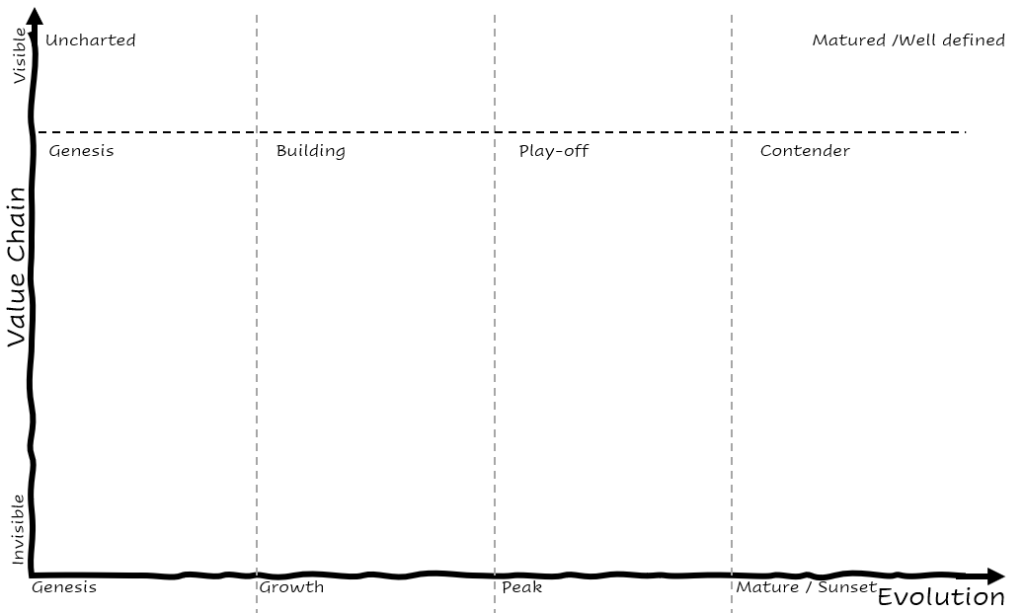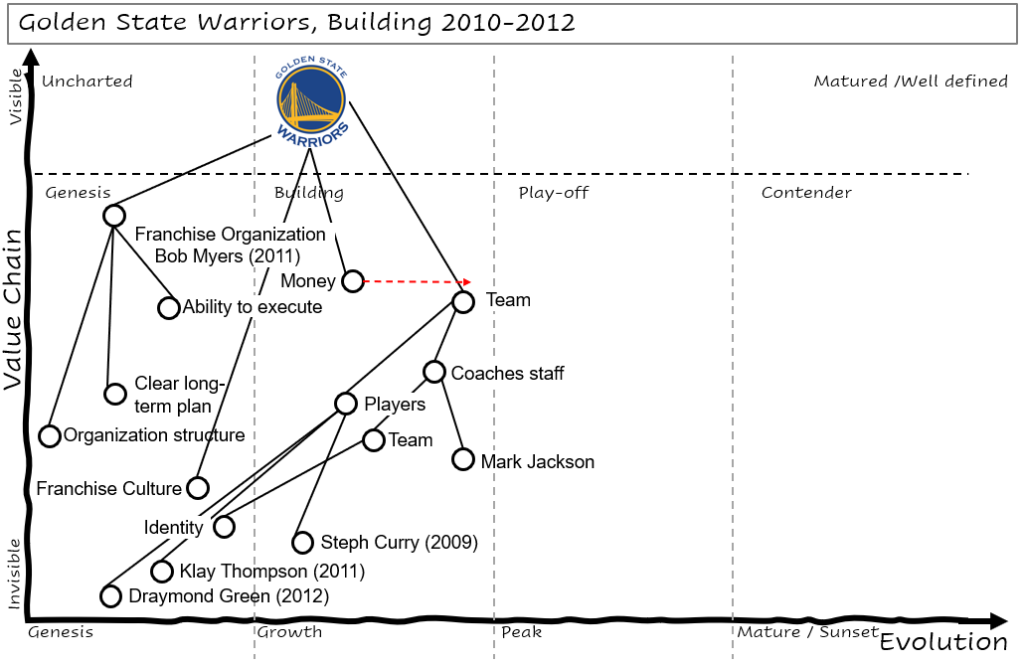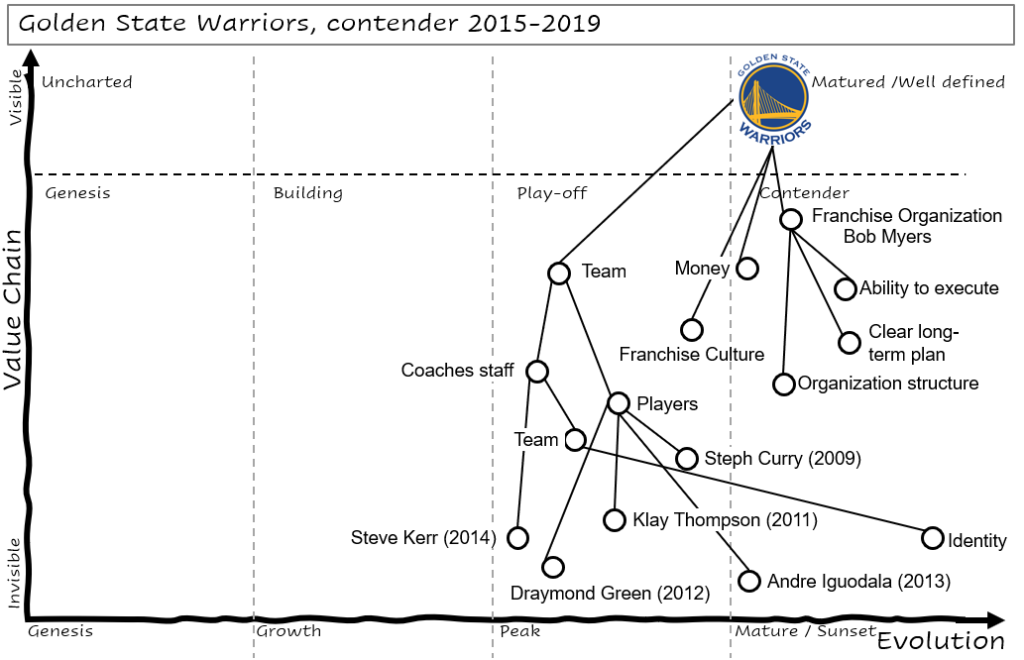The basketball teams evolves from different stages going back and forth depending on so many variables and factors.
To understand better the evolution of the teams, I’m going to define a set of stages where each team can mainly fit.
This will make the teams to evolve from one stage to others. These moves are mainly in terms of seasons or radical changes provoked by a major event.
There are always unknowns-uknowns, uncertainly and
Genesis (popularly known as “tanking”)
Teams in this stage are new franchises, teams that are ending the season in the last 10% of the ranking or teams that are being affected by a major event (ownership change, franchise player leaving…).
Typically the teams that fall into this stage are here for a period of time, but it’s common they will go to the next stage by building their own new future.
It can happen that a team is in this stage for long period of time. This situation is considered unusual but can happen.
A couple of examples:
- Houston Rockets: In season 2020-21, after losing their franchise player.
- Philadelphia 76ers: during the years where Joel Embiid and Ben Simmons were part of the team but were injured. These years were called “the process”.
- Indiana Pacers (2006 – 2010) after Reggie Miller retired, they had some seasons where they did not find a clear direction.
How do they exit from this stage?
The natural step of the teams in “genesis” is to jump to “building” stage, that happens that they have a clear core capabilities and potential resources that they are going to focus on. It’s not natural that they could go directly to “play-off” stage, but it could happen if a big number of trades happen.
Building
Teams in this stage have defined some of their pillars and are working on them to evolve. There is so much uncertain on these teams, and there is a lot of potential that needs to turn into reality: organization, leadership, structure, team, players, players fit…
Depending on the financial capacity the teams are in this stage more or less years. It depends on the long term roadmap the franchise has. Teams here has to start to show some type of consistency during the regular season. There will be ups and downs, but with some consistency.
A couple of examples:
- Golden State Warriors between 2011-2013.
- Indiana Pacers (2010-2011): after drafting Paul George and Lance Stephenson, the Pacers were able to build around them a team. They stayed in “genesis” stage for some years, but quickly went from “building” to “play-off”.
- New York Knicks (2013-2020) the team was supposed to be build around Carmelo Anthony, but different attempts failed and they never reached the play-offs.
How do they exit from this stage?
The natural step of the teams in “building” is to jump to “play-off” stage. This happens when they have a clear core capabilities that are working and they are demonstrating consistency during regular season. Their potential to grow is clear and depending of the talent and team their peak is still be discovered.
Play-offs
A play-off team has a clear roster, probably with 3-5 key players that have been in the franchise for some years. There is a clear doctrine and culture of the team and all this stability enables them to compete and look for the play-off as the target.
There are play-off teams that are build financially with a big-3 model where very talented people carries the responsibility to accommodate the franchise in a play-off position. Here depending on that talent and the climatic patterns (external factors) they will reach different play-off rounds.
A couple of examples:
- Portland Trail Blazers (2014-2017): After drafting Damian Lillard (2012) and C.J. McCollum (2013) they started to have continuous appearances in play-offs. They quickly moved from “building” to “play-off” after being some years in “genesis”.
- Boston Celtics (2015-2017): this team was reaching they play-off while they were being build. This was possible thank to the great talent they had in the roster, making them a potential contender for the following years.
How do they exit from this stage?
The natural and desired step of the teams in “play-off” is to jump to “contender” stage. This happens when they have demonstrated strong performance during the regular season, and they have potential and talent to reach the conference finals.
There is a non desired evolution in teams and is that they are aspiring to be a “contender”, but for some reason the team evolves to “genesis” or to “building” stage. This can happen by so many reasons: injuries, trades of key players, team reaches its peak (talent, maturity…).
Contender
A contender is a team that aspire to be in the first 5 teams of its division and with the potential to reach the conference finals. It’s build with a clear core roster of experienced players and some potential young or veterans that are expected to show-up during the season. Their ability to perform at high level is clear and they can defeat any other team in the league during the regular season.
A contender is looking into the play-off since the pre-season and is working to be ready and in shape during the play-off. The will play “load management” to reserve key players and will work on tactics to react to potential competitors during play-offs.
For a contender, to lose during the 1st play-off round is a fiasco, to reach the conference finals is the expectation, to reach the NBA finals a great price and to win the NBA finals is the Jackpot.
A couple of examples:
- Portland Trail Blazers (2018-2019): They were in play-offs during some seasons, but during these years they had the potential to reach the finals and they did it once.
- Houston Rockets (2016-2018): the team lead by James Harden was opting to the finals for years. They were having the problem of coexist with Golden State Warriors, another contender that dominated the league during 5 years.
- To me, any team reaching the conference finals is a contender. It’s very complex to put a franchise to compete at that level of performance, and right now it’s very unusual that a team reaches that level without a strong construction of their pillars (culture, organization, team and players).
How do they exit from this stage?
The natural and desired step of the teams in “contender” stage is to win a championship and stay on the top for some years. Contender teams use to be at this stage for some years and they stop being contenders by many reasons:
- The project itself is over.
- The main stars are in decline.
- A big fiasco the previous season that destroy the project.
- Etc.
Some teams step-back to “play-offs” stage but majority jump into “building” stage.
The speed of evolution is not linear
There are franchises that are able to move quickly from genesis to contender, and this is basically thanks to trades that enable them to position themselves in that new scenario. This is unusual, but can happen.
One of the most quick reconstructions happened ever is Boston Celtics (2007-2008). Boston came from two years without play-off presence, they dominated the regular season and they won the NBA title. Probably this was the quickest jump from building to contender and winner of the NBA history.
The reality of the rest of the franchises are different, they are build on long term plans around some key players, but that it takes years to be a consistent contender with ability to win the NBA title.
The evolution of a franchise depends on the evolution of its components
A franchise is composed by different components: culture, organization structure, team and players. These four components could be set as the pillars of a franchise. To have a contender team it’s not unusual that their main components are matured enough or in their peak.
I have created a different stage nomenclature to the components to reflect that the individual components evolution, that can be independent to the evolution of the franchise (2+2 not always sum-up 4):
- Genesis: An asset at this stage has an unknown performance: a new franchise owner, rookie players, new head coach… It could be that the component is not new, but it’s set on a completely different context, and by that reason, we place it in Genesis.
- Growth: asset is turning from unknown (genesis) and is growing quickly to a known performance (maturity), the peak is still not 100% clear, but there is potential ahead.
- Peak: Stage of high performance that can be there for several years. For instance players can be performing at high level for years, but their way to play evolves as their age is different (from more physical playbook to more cerebral execution).
- Mature / sunset: A player can reach its sunset (as veteran) but a franchise organization can stay matured for years. Fan base of a team can be “mature” too, teams as Boston or New York has a wide fan base that are there every single season.
This is by the moment the proposed template:

Inertia
The inertia is the evolution without effort, using the energy and work done in the past. The teams need additional energy and effort to move from one stage to other. If they do not do it, they will fall in the inertia and potentially this will lead them to fall back to other stage.
For instance: a team that is in play-offs for several years but they are not able to reach the conference finals will have some type of erosion that will lead them to lose their ability to maintain the status.
An example
This is the first map I do of a franchise using these concepts and template. I hope the evolution is understood.



All maps are wrong, but some are useful.
Simon Wardley
Any constructive feedback is welcome, this is just a draft.